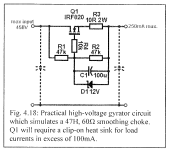This popular gyrator smoothing choke works well in a positive supply. Now I'd like to use it to smooth a negative bias supply where the positive of that is referenced to HT ground. So can I just simply put this "two wire" gyrator in line with the bottom negative wire instead of the top wire? Like I could if it were a real choke? IOW simply flip it upside down. are there any polarity issues with doing that?

Attachments
I'm looking at lower voltage (50-100V) P-channel mosfets that are somewhat similar to IRF820, for converting this circuit to a negative leg gyrator for an unregulated bias supply. I noticed that most N-channel mosfets have a much lower Rds (drain source on resistance) than the IRF820, most are well under .5 ohms whereas the IRF820 is a whopping 3 ohms.
Is there an advantage in this circuit to using a high Rds device? Or can I basically use any N-channel power mosfet as long as its Vds is over the voltage I'm using?
The reason I ask is because there are very few P-channel fets with an Rds of 3 ohms but a great many under .5 ohms. Is a device with high Rds critical in this circuit or not is my question I guess. Or was the IRF820 simply chosen here because the author had some of those on hand. Newark has a lot of P-channel mosfets on sale with low Rds.
Is there an advantage in this circuit to using a high Rds device? Or can I basically use any N-channel power mosfet as long as its Vds is over the voltage I'm using?
The reason I ask is because there are very few P-channel fets with an Rds of 3 ohms but a great many under .5 ohms. Is a device with high Rds critical in this circuit or not is my question I guess. Or was the IRF820 simply chosen here because the author had some of those on hand. Newark has a lot of P-channel mosfets on sale with low Rds.
No issue afaik, as Vds doesn't fall down to near 0V except at some high current limit, or low input voltage limit, and having a Vds min that is 2.5x0.25=0.5V lower should have no nominal influence on operation.
